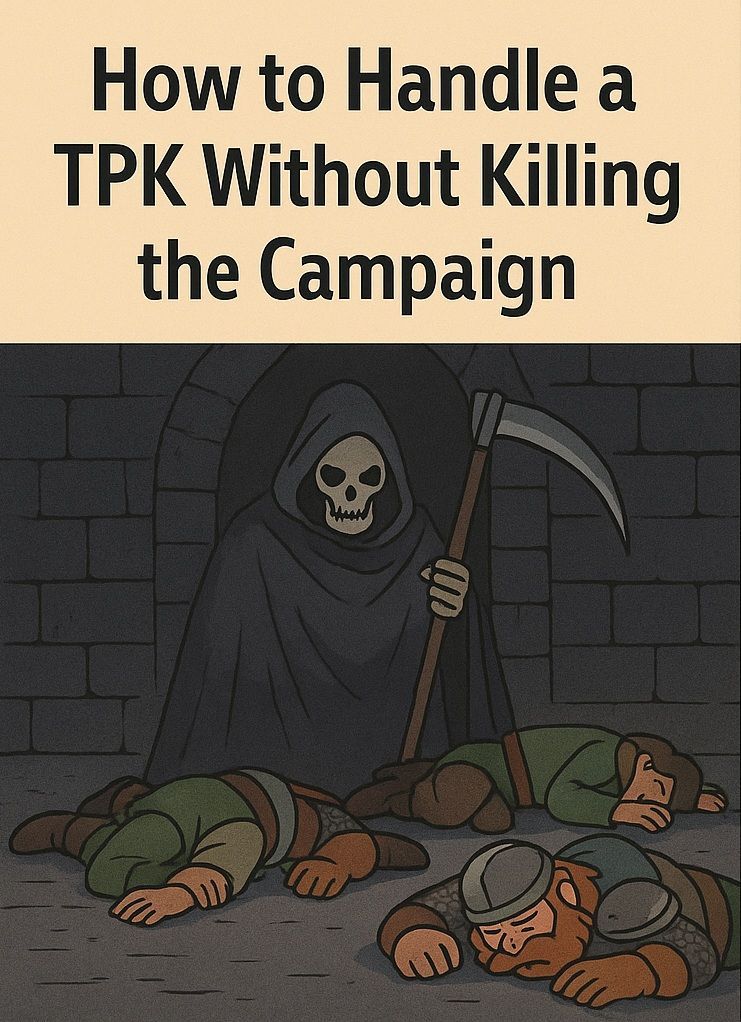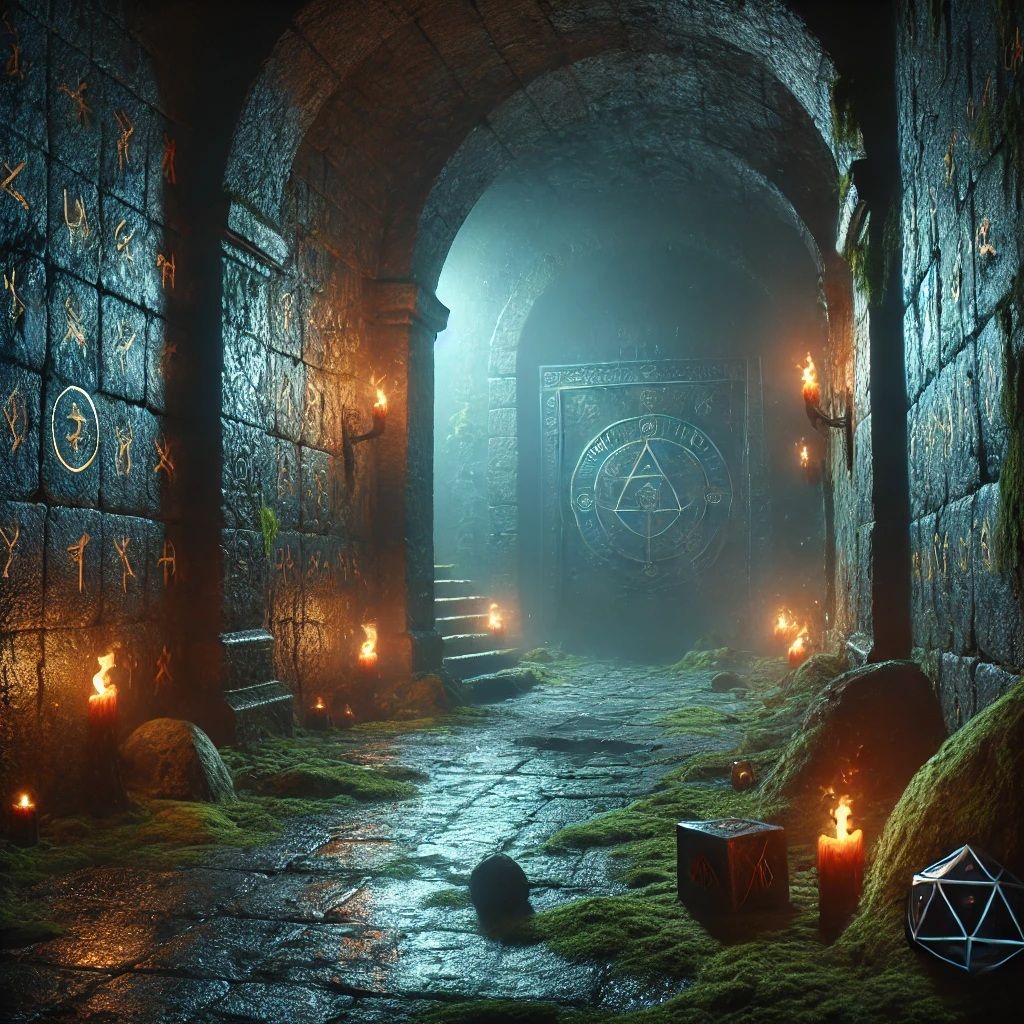Mystery Campaigns: Crafting Intricate and Engaging Mysteries
First and foremost, Dearest Readers, I want to say “HAPPY ANNIVERSARY!!” That’s right, we hit 4 years of this blog going strong (as of tomorrow, exactly). I want to thank each and every one of you, Dear Readers, for your comments, your likes, and most of all, giving this DM the time of day enough to read what I’ve written. With all of my heart, I want to say, “Thank you!”
Dear Readers, welcome back to our Dungeons & Dragons (D&D) blog! Today, we’re venturing into the thrilling and enigmatic world of mystery campaigns. Crafting an intricate and engaging mystery can add layers of intrigue, suspense, and intellectual challenge to your game, offering players a unique and rewarding experience. A well-constructed mystery involves more than just puzzles and clues; it weaves a narrative that captivates players, encourages critical thinking, and provides satisfying resolutions. In this post, we’ll explore the key elements of mystery campaigns, provide tips for designing compelling mysteries, and offer practical examples to inspire your own adventures. So, let’s dive into the art of mystery crafting and uncover the secrets to creating unforgettable mystery campaigns.
The Appeal of Mystery Campaigns in D&D
Mystery campaigns bring a unique flavor to D&D, blending elements of investigation, deduction, and suspense with traditional fantasy adventures. Here are some reasons why mystery campaigns are particularly appealing:
1. Intellectual Challenge
Mystery campaigns challenge players’ minds, requiring them to piece together clues, solve puzzles, and make logical deductions. This intellectual engagement can be highly satisfying and rewarding.
Example: Players must decipher an ancient code that leads to a hidden treasure, requiring careful analysis and problem-solving.
2. Engaging Narrative
Mysteries often involve intricate plots and compelling storylines, drawing players into a narrative that is rich with twists, turns, and revelations.
Example: A seemingly straightforward murder investigation reveals a deeper conspiracy involving dark magic and political intrigue.
3. Character Development
Mystery campaigns provide opportunities for character development, as players must interact with NPCs, uncover secrets, and confront moral dilemmas.
Example: A player character must confront their own past when an old acquaintance becomes a key suspect in a series of crimes.
4. Enhanced Role-Playing
The investigative nature of mysteries encourages role-playing, as players question witnesses, interrogate suspects, and navigate social dynamics.
Example: Players must gain the trust of a reclusive hermit who holds crucial information about the mystery they are trying to solve.
Key Elements of a Mystery Campaign
To craft an engaging mystery campaign, it’s important to incorporate several key elements that contribute to the overall experience:
1. A Compelling Central Mystery
At the heart of any mystery campaign is a compelling central mystery that drives the narrative. This could be a murder, theft, disappearance, or any other puzzling event.
Example: The players are hired to investigate the disappearance of a prominent noble, uncovering a web of lies, secrets, and hidden agendas.
2. Well-Developed Clues
Clues are the breadcrumbs that guide players through the mystery. These should be carefully designed and distributed, providing enough information to keep players engaged without giving away the solution too easily.
Example: Clues might include a torn piece of fabric found at the crime scene, a cryptic message left behind by the victim, and witness testimonies that provide conflicting accounts.
3. Intriguing NPCs
NPCs play a crucial role in mystery campaigns, serving as witnesses, suspects, allies, and antagonists. Each NPC should have their own motives, secrets, and personalities.
Example: Key NPCs might include the victim’s estranged sibling, a shady merchant with ties to the underworld, and a local cleric with a hidden past.
4. Red Herrings
Red herrings are false leads or misleading clues that add complexity and challenge to the mystery. They can keep players on their toes and prevent the solution from being too straightforward.
Example: A seemingly damning piece of evidence points to an innocent NPC, diverting the players’ attention and complicating the investigation.
5. Logical and Satisfying Resolution
The resolution of the mystery should be logical and satisfying, providing a sense of closure and accomplishment. Ensure that all clues and plot threads come together coherently.
Example: The players discover that the noble’s disappearance was orchestrated by a jealous rival who used illusion magic to stage the crime, providing a twist that ties all clues together.
Tips for Designing Compelling Mysteries
Designing a compelling mystery campaign requires careful planning and creativity. Here are some tips to help you craft an engaging and intricate mystery:
1. Start with the Solution
Begin by determining the solution to the mystery. Knowing the answer from the outset allows you to work backward, planting clues and red herrings that lead logically to the resolution.
Example: Decide that the missing noble was kidnapped by a rival seeking to disrupt a political alliance. This solution informs the design of clues and NPC motives.
2. Create a Timeline
Develop a timeline of events leading up to and following the central mystery. This helps maintain consistency and provides a framework for players to reconstruct what happened.
Example: Create a timeline detailing the noble’s movements, interactions, and significant events in the days leading up to their disappearance, as well as the actions of key suspects.
3. Distribute Clues Carefully
Distribute clues carefully to ensure a balanced flow of information. Avoid overwhelming players with too many clues at once or leaving them without enough information to progress.
Example: Introduce clues gradually, starting with obvious evidence and gradually revealing more subtle or complex clues as the investigation progresses.
4. Develop NPC Motivations
Give each NPC clear motivations and backstories that explain their actions and behavior. This adds depth to the characters and makes the mystery more believable.
Example: The estranged sibling resents the victim’s success, the shady merchant has financial troubles, and the local cleric seeks to protect a dark secret from their past.
5. Incorporate Multiple Layers
Add multiple layers to the mystery, including subplots and secondary mysteries. This complexity can make the investigation more engaging and provide additional challenges.
Example: While investigating the noble’s disappearance, players uncover a smuggling ring operating in the city, leading to a secondary mystery that intersects with the main plot.
6. Use Varied Clue Types
Incorporate a variety of clue types, including physical evidence, witness testimonies, documents, and magical signs. This variety keeps the investigation dynamic and interesting.
Example: Clues might include a bloodstained dagger, a secret ledger, a coded message, and traces of magical residue at the crime scene.
Practical Examples of Mystery Campaigns
To illustrate how you can apply these elements, here are practical examples of mystery campaigns for different types of adventures:
Example 1: The Missing Heir
Central Mystery: The players are hired to investigate the disappearance of Lord Aric, the heir to a powerful noble family. His sudden disappearance threatens to plunge the region into chaos.
Clues:
- A torn piece of Aric’s cloak is found near the stables, suggesting he was taken by force.
- A hidden diary in Aric’s room reveals a secret love affair with a commoner.
- Witnesses report seeing a cloaked figure leaving the estate on the night of the disappearance.
- A cryptic letter addressed to Aric, warning him of danger, is discovered in his study.
NPCs:
- Lady Elara: Aric’s stern and overprotective mother, who is desperate to find her son but hides her own secrets.
- Captain Thorne: The head of the estate’s guard, who harbors a grudge against Aric.
- Mara: A commoner who was romantically involved with Aric and may know more than she initially reveals.
- Duke Renfield: A rival noble who stands to gain from Aric’s disappearance and has a history of underhanded dealings.
Red Herrings:
- A stable hand with a history of petty theft is found with a valuable ring belonging to Aric, but he insists he found it discarded.
- An old family feud with a neighboring estate initially points suspicion towards them, but they have a solid alibi.
Resolution: The players discover that Aric was kidnapped by a group of mercenaries hired by Duke Renfield. However, the plot thickens when it’s revealed that Lady Elara knew about the danger and withheld information to protect her own reputation. The players must navigate a web of deceit to rescue Aric and prevent a regional conflict.
Example 2: The Cursed Relic
Central Mystery: A valuable relic is stolen from the city’s temple, and soon after, a series of mysterious illnesses begin to plague the city. The players are tasked with recovering the relic and uncovering the source of the curse.
Clues:
- A broken window at the temple suggests the thief’s entry point.
- A trail of strange, glowing dust leads from the temple to the marketplace.
- A black market dealer is found with a piece of the relic, claiming he bought it from an unknown seller.
- An old book in the temple’s library details the relic’s history and its connection to an ancient curse.
NPCs:
- High Priestess Liora: The temple’s leader, who is deeply concerned about the theft and the ensuing curse.
- Jax: A rogue and former temple acolyte with a history of petty crimes, now working in the marketplace.
- Talia: A scholar who specializes in ancient curses and offers her expertise to the players.
- Garrik: A mysterious figure seen lurking around the temple shortly before the theft, with a hidden agenda.
Red Herrings:
- A local rival temple is initially suspected of orchestrating the theft to undermine the players’ temple but has no involvement.
- An herbalist is found with a potion that mimics the symptoms of the curse, raising suspicion before it’s revealed to be a coincidence.
Resolution: The players uncover that the relic was stolen by Garrik, who sought to harness its power for his own dark purposes. The glowing dust is revealed to be a residue from a rare plant used to activate the relic’s curse. The players must confront Garrik and reverse the curse, restoring peace to the city.
Example 3: The Haunted Mansion
Central Mystery: The players are invited to investigate a series of hauntings at a dilapidated mansion owned by the reclusive Lord Blackwood. The hauntings have terrified the staff and driven away potential buyers.
Clues:
- A journal found in the library details Lord Blackwood’s obsession with the occult and his experiments with necromancy.
- A hidden passage in the basement leads to a forgotten crypt filled with ancient bones and eerie symbols.
- An old painting in the hallway depicts a figure resembling Lord Blackwood, but with sinister alterations.
- Strange, spectral visions of a woman in a tattered dress appear at midnight, leading the players to key locations in the mansion.
NPCs:
- Lord Blackwood: A reclusive noble with a dark past, who is both a victim and a suspect in the hauntings.
- Martha: The loyal housekeeper who has served the Blackwood family for decades and knows the mansion’s secrets.
- Elias: A rival scholar of the occult who has a vendetta against Lord Blackwood and might be involved in the hauntings.
- Lady Isolde: The ghost of Lord Blackwood’s former wife, whose restless spirit haunts the mansion.
Red Herrings:
- A series of prank hauntings staged by local youths looking to scare the staff and explore the mansion’s secrets.
- A cursed mirror that shows false visions, leading players to suspect the wrong individuals.
Resolution: The players discover that Lord Blackwood’s experiments with necromancy inadvertently bound Lady Isolde’s spirit to the mansion. To free her and end the hauntings, the players must perform a ritual using items found in the crypt and confront the vengeful spirit of Elias, who has been amplifying the hauntings to ruin Lord Blackwood.
Techniques for Running Mystery Campaigns
Running a successful mystery campaign involves more than just designing the mystery; it requires careful execution and player engagement. Here are some techniques to help you run an effective mystery campaign:
1. Encourage Player Collaboration
Mystery campaigns thrive on collaboration and discussion. Encourage players to share theories, pool information, and work together to solve the mystery.
Example: Facilitate group discussions after key revelations, allowing players to brainstorm and connect the dots collectively.
2. Provide Recaps and Summaries
Mysteries can be complex, and players might forget important details between sessions. Provide recaps and summaries to keep everyone on the same page.
Example: At the start of each session, recap the key clues and developments from the previous session to refresh players’ memories.
3. Use Handouts and Props
Handouts and props can enhance immersion and provide tangible clues for players to examine. This can include letters, maps, photographs, and physical objects.
Example: Create a handout of the torn diary entry or a map with marked locations where key events occurred, allowing players to physically piece together clues.
4. Manage Pacing and Tension
Balance the pacing of the mystery to maintain tension and engagement. Alternate between moments of intense investigation and periods of reflection and discussion.
Example: Introduce time-sensitive elements, such as a looming deadline or escalating stakes, to keep the investigation moving forward.
5. Allow for Creative Solutions
Encourage players to think creatively and consider unconventional solutions to the mystery. Be open to different approaches and reward ingenuity.
Example: If players devise a clever plan to trap a suspect using magic or disguise, allow it to succeed and advance the investigation.
6. Adapt to Player Choices
Be prepared to adapt the mystery based on player choices and actions. Flexibility ensures that the story remains dynamic and responsive to the players’ decisions.
Example: If players decide to investigate a location you hadn’t anticipated, improvise and incorporate new clues or encounters that tie into the overall mystery.
Incorporating Mystery Elements into Other Campaign Types
Mystery elements can enhance various types of campaigns, even those not primarily focused on investigation. Here are examples of how to incorporate mystery elements into different campaign types:
1. Dungeon Crawl
Scenario: While exploring an ancient dungeon, players discover signs of a previous expedition that vanished without a trace. They must uncover what happened to the missing explorers.
Mystery Elements:
- Clues include journal entries, scattered equipment, and strange symbols on the walls.
- NPCs might include a surviving member of the expedition, a rival adventuring party, and the dungeon’s original inhabitants.
- The resolution involves piecing together the explorers’ fate and confronting the dungeon’s guardian.
2. Political Intrigue
Scenario: In a city rife with political tension, a prominent council member is found dead under mysterious circumstances. Players are tasked with investigating the death to prevent further chaos.
Mystery Elements:
- Clues include financial records, secret correspondences, and conflicting witness testimonies.
- NPCs might include rival council members, the victim’s family, and influential merchants with hidden agendas.
- The resolution involves uncovering a conspiracy and preventing a coup.
3. Wilderness Exploration
Scenario: While exploring a remote wilderness, players come across an abandoned settlement with signs of a sudden and violent evacuation. They must uncover what drove the settlers away.
Mystery Elements:
- Clues include damaged structures, cryptic messages carved into trees, and signs of struggle.
- NPCs might include nearby tribes, wandering hermits, and the remnants of a scouting party.
- The resolution involves discovering a hidden threat, such as a monstrous creature or ancient curse.
Conclusion
Crafting intricate and engaging mysteries can add depth, excitement, and intellectual challenge to your D&D campaign. By incorporating a compelling central mystery, well-developed clues, intriguing NPCs, and logical resolutions, you can create a rich and rewarding experience for your players.
Remember to encourage player collaboration, use handouts and props, manage pacing and tension, and adapt to player choices. Whether your campaign is focused on investigation or incorporates mystery elements into other genres, these techniques will help you create memorable and immersive adventures.
Until next time, Dear Readers…
























